

The spinning slowly subsides and we stagger to our feet. The skies are clear blue and, though we still seem to be in a park, it is clearly different from the one we left. We follow a pathway to exit onto a busy street. Behind us, the gate pillar wears a tarnished brass plate: "West Smethwick Park". We're back in Birmingham! Phillips Cycles are just down the road at Credenda Works, so let's pop in for a cup of tea!
It's nice to see Tom Winsper (Works Director) again, but he's clearly troubled about future prospects for the plant (not without good reason, since, dear reader, we know that dark days lie ahead for the Phillips brand, but our technology only allows us to visit history - we cannot change it).
In 1959, several of the British Cycle Corporation companies were on the move: Brampton Fittings had been relocated to South Wales to share the Phillips Lion Works at Newtown; Brampton's vacated Britannia Works at Downing Street, Handsworth was re-occupied by Hercules and James Cycles from 2nd January, as they moved from the old site at Aston; then further joined as office for Aberdale as the Edmonton factory closed in February.
Tom leads us through a side door from the boardroom, down a set of stairs, emerging in a gloomy garage off the back courtyard. Bathing in a pool of weak sunlight that has filtered through the dirty windows, stand three mopeds in a row.
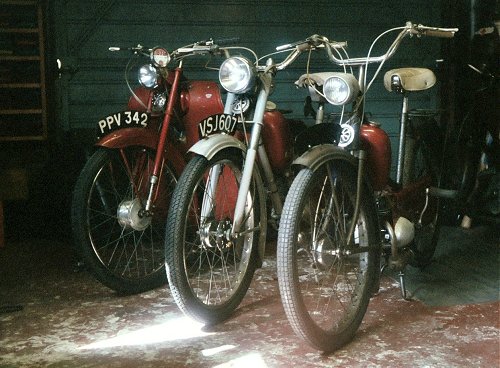
In gunmetal and red with its Rex engine, the first is the Phillips Panda Mk1. Second, in grey and red with telescopic forks, is the Phillips Panda Mk2. "And this," he gestures to the third machine, "The new Phillips Panda Mk3. Perhaps IceniCAM might care to try them out, and tell us what you think?"
Our history would seem to begin back in 1892 as J A Phillips and E W Bohle started their business making cycle pedals at Newhall Street in Birmingham, and in 1919 became one of the original five companies merged to form Tube Investments. The TI group seemed quite a liberal association, as Phillips appeared to continue trading independently, manufacturing components for the cycle trade up to the early 1930s, when they started producing 'export parcels' of all the components required to build up a complete bicycle. From there it was only a short step to making-up frames for the home market by the mid-30s, then building complete bicycles under their own brand toward the end of the decade.
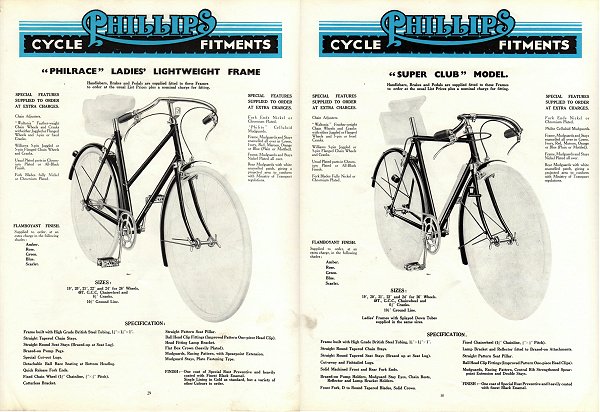
Home market cycle frame kits, c1936
During the 2nd World War, Phillips switched to munitions work, producing vast quantities of shells (89 million!), armour piercing tips, grenades, land mines and aircraft parts. The Smethwick and Handsworth works commenced refitting in 1945 as world conflicts concluded and military contracts eased, then Phillips returned to the cycle trade.
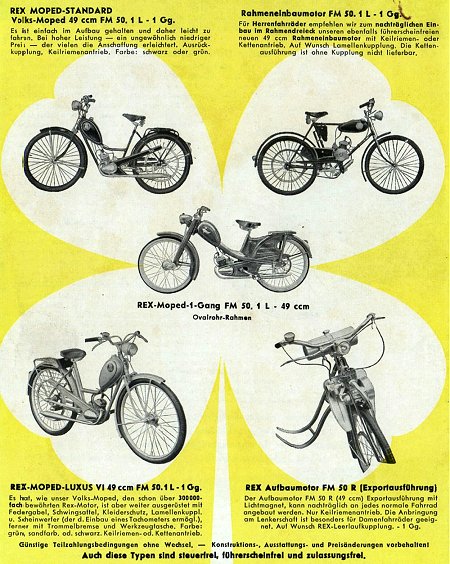
Rex-Motorenwerk of Munich was established as one of the German cyclemotor pioneers in 1948, producing their FM31 31cc, 0.7bhp cyclemotor attachment engine to mount above and drive the front wheel of a bicycle by belt, to a pulley rim that was clamped to the spokes. In 1950 this motor was licensed to British Salmson for manufacture at Larkhall near Glasgow, becoming more familiar to British cyclemotorists as the rear-mounted Cyclaid. Further front-mounted Rex cyclemotor versions followed: the FM34 (34cc, 0.8bhp), FM40 (40cc, 0.9bhp) cyclemotor engines and FM50 (50cc, 1.1bhp with 10mm Pallas carb. The subsequent FM50.1 variant with Pallas 12mm carb raised the power rating to 1.4bhp and superseded all earlier forms by 1955, then being offered by Rex as cyclemotor sets for front mounting with belt drive, or in-frame location with belt drive or clutched chain drive versions of the motorised cycle kit. Apart from the cyclemotor kits, Rex were now also producing their own complete mopeds based on the FM50.1 motor, in a puzzling choice of models with left or right handed belt drive in a brazed-lug tubular frame.
Phillips took up a licence to market Rex products in the UK, heralding the start of a trading relationship between the two companies with introduction of the Phillips P36X Motorised Cycle in October 1954. While Rex only sold these models on the continent as a cyclemotor engine attachment kit, the Phillips Company only sold them in Britain as a complete branded machine built onto their own heavy-duty cycle frame. These early models are characterised by a rigid fork set reinforced with bracing struts, then a MkII version with telescopic forks followed from October 1955, that was listed up to November 1958. The Motorised Cycle was succeeded by the Panda Mk1 moped in February 1959, being a licence-built version of the first Rex moped brazed-lug tubular frame design, and was the last commercially adapted installation of the FM50.1 motor, which was now using a 12mm Bing carb. The Rex single-speed motor design is interesting and unusual in that it uses the induction gasses to lubricate the gear and bearings of the primary reduction drive, which is all housed in an extended section behind the crankcase. All market Rex engines used Bosch flywheel magneto sets up to June 1957, after which the Bosch equipment continued for the continental market, while the Phillips UK market Rex motors were mounted with Miller flywheel magneto sets.
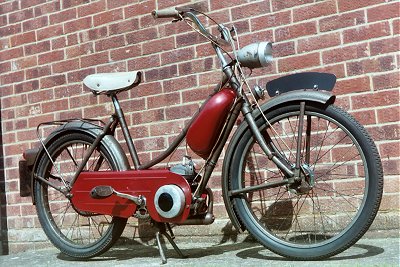
Aside from the proprietary engine and licence-built frame design, Phillips were making much of the Panda themselves, including the Excelite headlamp set which was a product from the Credenda Works. Excepting the Dunlop Endrick gunmetal painted rims laced on to the Perry Coaster rear hub, and other Miller electrics, mostly all the cycle frame fittings came from within the British Cycle Corporation group of companies. The frame may look primitive, but it is certainly sturdily built, and fitted with heavy gauge commercial fork set. In contrast, the centre stand appears rather a dainty item, and doesn't look as if it would resist many frantic pedalling efforts on the stand if the engine were reluctant to start. Fortunately, any such concerns are unnecessary with this example. To start our Mk1 test machine on the stand: fuel on and push down the inaccessible choke rod on the carb top, tucked away down below the engine panels. Pull in the clutch to turn the pedals to a suitable starting position, release again to engage the motor, taking up the slack on the throttle, right trigger decompress to spin the motor and release. After a couple of repetitions the engine fires up, then ease back the throttle to lift off the choke.
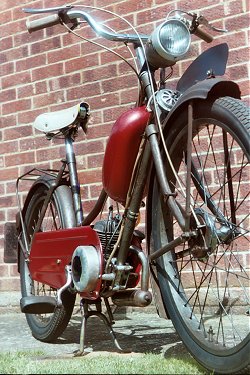
Our Mk1 Panda features a modified exhaust porting arrangement in the cylinder, and accelerates smoothly with no four-stroking, for a best pace on the flat of up to 28mph according to conditions, and frantically over revving to top 32mph downhill. Happiest cruising speed is found in the low 20s, and Phillips's own 3¼" Excelite headlamp seems bright enough, but the puddle of light is rather vaguely splashed and appears not to be making the best of its 15W bulb, though it generally proves adequate for the sedate performance.
It's as well the Panda isn't any speed machine since the half width B H Co front brake performs quite poorly, though easily manages to eclipse the completely ineffective Perry Coaster back-pedal rear hub arrangement.
Panda Mk1's practicality is simplicity and lightness. The rigid fork and hard tail prove quite satisfactory within normal cruising expectation on public roads, though will certainly convey some shattering jolts if a rider fails to avoid the potholes. The Phillips Panda P40 moped certainly looks quite an ancient machine to anyone looking at the bike today. You may well be excused for thinking it's older than it is since, compared to many of the more stylish, pressed frame continental mopeds of the day, it probably looked pretty old-fashioned when the Phillips Cycle Company announced the model in the spring of 1959, priced at £55-2s-6d. In contrast, Raleigh's equally prehistoric looking, though clutchless, RM1, was listed at £48-16s-6d at this time: 11% cheaper, and below the magical £50 milestone.
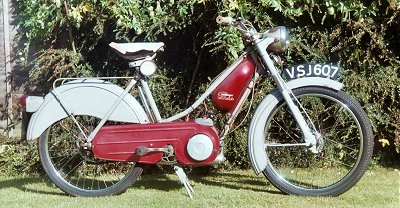
Tube Investments Group agreed terms for the take-over of Raleigh on 19th April 1960 and, in March, Phillips had announced their new 'Panda Plus' at a price now risen to £57-4s-6d. Though the P49 Mk2 was introduced and being delivered to dealers from May 1960, the Mk1 remained available over that year's sales season, before being de-listed in November 1960.
The ride on the Mk2 Panda is really no improvement on the rigid fork of the Mk1 since, despite having a set of telescopics up front, these are grossly oversprung and deliver little practical suspension effect. The front wheel is now built on a balancer flange hub, being nothing more than a detail change with a larger non-brake side flange plate to allow standard length spokes both sides of the wheel, so no real customer benefit there! Unfortunately, the Perry Coaster hub is still retained at the rear and, no surprise, the back pedal bronze cone brake on this machine proves predictably consistent in performance with every other example that we've ridden - utterly useless! Any retarding effect on forward motion could generously be described as negligible!
Another obvious change on the Mk2 is the addition of side valanced panels on the rear mudguard, which are so deep that any side spray in wet weather would be completely contained. Whether the rear trim offers significant practical gain is probably questionable, since most side spray from the rear falls behind the rider, and the feature more likely results from some quirky styling diversion that was briefly adopted by several manufacturers about this time. The front mudguard is also equipped with added valances, less excessive in proportion, though very practical in preventing the side spray that traditionally soaks the cyclist's legs and ankles, and fills his shoes with water.
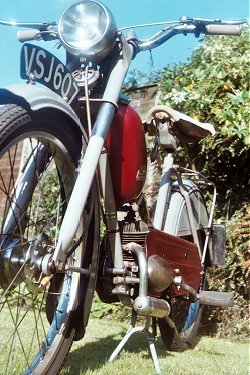
The bigger 4½" Miller headlamp makes better use of the power generated from the Miller 6V, 18W magneto set, and offers appreciably better illumination than the previous Excelite. Flatter handlebars on this Mk2 Panda do change the riding position; where the height adjustable high-rise bars of the Mk1 favour a more stately and upright posture, the Mk2 induces the rider to 'lean ahead' in a slightly sporting crouch. This Mk2 Panda still has its standard original motor, and performance is typically as expected. Pushing the choke rod down on the carb is still as inaccessible as the Mk1, trigger decompressor on the throttle twistgrip, then pedal away to practice our flying start. Let off the trigger to drop the clutch, and the Rex motor fires up immediately, though it's a bit flat and hesitant with a cold engine at the moment. We coax the machine up to 20mph, where phases of four-stroking start to kick in, though this does abate a little once the motor gets hot after a few miles. The Rex engine shows its cyclemotor heritage by not wanting to be hurried, being happiest cruising about 20mph, with a low roar from the carb induction harmonising with the mellow drone of the exhaust tone. The best speed on the flat is nominally around 25mph according to conditions, with Panda readily shedding speed against even a shallow gradient or light headwind, and noticeably gaining a little more as the conditions become marginally more favourable. On the test circuit gradient, speed fell back to 17mph, where it settled down to soldier up the incline. The pace bike recorded a best downhill of 31mph, at which the little Rex was angrily buzzing like a tin of enraged bees! There was no need to adopt any prone position in this case, the motor plainly had no more to give. Considerable vibrations were tingling through the handlebars, pedals, and the uncomfortable Wrights E1 rubber saddle frame, at which speed it was quite apparent that the engine was into territory it didn't want to be.
In October 1960, Raleigh de-listed their Sturmey-Archer powered RM2c moped.
On January 15th 1961, 1,000 workers at Phillips Smethwick factory stopped work for the rest of the day, in protest against a BCC announcement to concentrate cycle production at Nottingham. The following day, cycle production at Raleigh was cut back 30% due to falling orders and built-up stocks, with 7,000 employees going to a 4-day week from January 27th. In February 1961, Raleigh introduced their new RM4 moped, a licence-built machine based upon Motobécane components and assembled at Nottingham.
An ill wind of change began blowing through the TI/Raleigh Industries Group during April 1961, with the announcement outlining further restructuring of factories of the British Cycle Corporation. Now closures were announced of Norman at Ashford, Sun Cycle & Fittings Phoenix Works at Aston Brook St, J B Brooks in Great Charles Street, Birmingham, and Wrights Saddle Co of Dale Road, Selly Oak. A question hung over Phillips Lion Works at Newtown, and it was stated that over the next three years, manufacture of all bicycles for the group would relocate to Nottingham, while mopeds, scooters, motor cycles, saddle work & luggage from Brooks and Wrights was to concentrate at the Downing Street, Britannia Works. Onward turn the hands of time, and by 30th August 1961, Charles and Fred Norman retired as the Ashford factory doors closed for the last time. Tom Winsper had good reason to be concerned for Phillips' prospects as the bell tolls next for Bridge Street, Smethwick.

Our Panda Mk3 became listed from September 1961, though never rolled down the factory lines at Credenda Works. As a derivative of the RM4, it was built at the Raleigh Works in Nottingham. The Phillips had become no more than a group-assembled market-branded product.
The £62-17-1d Raleigh RM4 was pitched as top dog in this family of badged machines, with its two-tone paintwork, 'Super-Comfort' saddle, and integral speedo in the Luxor headlamp. A Norman Nippy Mk5 at £60-0s-0d filled the middle ground, also with two-tone scheme, still with the Super-Comfort saddle, but plain Lucas headlamp. Phillips found itself relegated to economy brand, priced at £59-0s-0d, with an archaic Wrights S.65/3 'tension coil sprung' saddle and mono-colour paint in sparkling Royal Carmine Red. The public took well to the flashing ruby finish and premium price tag, so the Phillips Panda actually sold very well, and we can see the attraction as we look over our smart and very original one-owner test machine dating from 8th September 1962. The striking metallic paintwork is eye-catching, warm and friendly, inviting the customer to 'come and buy'.

Starting the automatic Panda is very straightforward, lever tap on the fuel tank, which Raleigh neatly adapted from the Norman Lido to suit the Motobécane frame. Thumb the trigger choke to the left lever mount. Forward decompress with the Amal twistgrip, then roll back the throttle as the engine turns. The motor readily fires up, and the same procedure applies whether adopting a 'kickstart on the stand' style, or 'pedal flying start' up the road for that fast getaway! Well, actually not so fast if you leave all the acceleration to the 1.4bhp Motobécane automatic engine. 49cc at 6.5:1 compression, fed by a 10mm Gurtner carb isn't going to set the road alight. The Mk3 steadily plods onward to its destination, but manages to dig in to moderate inclines and gives a surprisingly reasonable account of itself, without much feeling that it'll prematurely ask for pedal assistance.
The undamped telescopic forks are firmly sprung to absorb the fiercest jolts within their short 1½" travel range, but consequently deliver rather a pogo ride along a bumpy lane, while you quickly become only too aware of the firmness of the rigid rear through the basic springing of the economy cycle saddle. The Super-Comfort saddle on the Raleigh RM4 and Norman Nippy Mk5 sure was money well spent!
The stem mounted handlebar set carries an Amal twistgrip, with Raleigh pattern levers hooked to 90mm full-width Prior alloy hub brakes that work every bit as good as they look, so stopping capability far exceeds performance of the bike. The exhaust note wears a strong and confident tone, but the engine is all bluff, and readily breaks into bouts of four-stroking from the limited porting as the motor comes off load. Getting the engine nice and hot over a 30 mile test run, the Mk3 delivered 25 - 28mph on the flat according to wind conditions, and was reluctantly 'encouraged' up to a peak of 33mph descending a long shallow downhill stretch. Over such distance, the seat becomes no friend, and the rider will be glad to get off at the end.
The 18W Novi 6V flywheel magneto set distributes 3W to the Lucas tail lamp, and 15W to the Lucas front, for a pale pool of dull golden illumination on the tarmac ahead that, mostly, seems adequate for the limited performance.
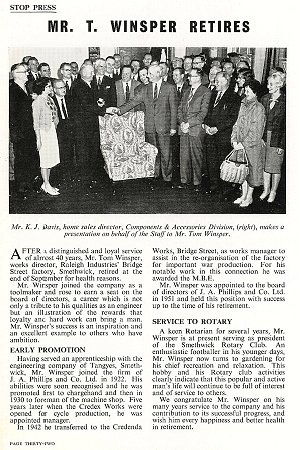
Tom Winsper's retirement
announced in The Raligram
The quality of general cycle fittings is particularly good, with effective and sweepingly valanced mudguards, long and stylish matching sidepanels, Raleigh's own pressed steel rack with saddle tube trim and two toolboxes. The 'Patrol' legshields in matching paint were available as an optional accessory, and do offer some comforting degree of protection to your lower body during adverse conditions, while actually having little handicapping effect to such a low performance vehicle. Panda Mk3 makes a sound and steady little commuter, practical over short distances, and generally only limited by its restricted performance and uncomfortable ride.
All three of our Phillips Pandas prove to be pretty slow, base model mopeds that can't really be hurried, so you're going to need to allow time to travel to your destination.
Tom Winsper's retirement from Bridge Street Factory, Smethwick, was reported in The Raligram trade news leaflet of November 1961.
The Panda Plus (Mk2) P49 moped was de-listed in December 1961.
Raleigh Service Memorandum No 7, dated 1st April 1963, advised dealers about introduction of a new 1.7bhp Motobécane motor for the Panda Mk3 from frame number 1P4679.
The gentle Phillips Panda mopeds were produced over turbulent times in the British cycle industry, and failed to re-appear in listings for the 1964 sales season, though unlike the Norman brand that vanished completely by autumn of 1963, the Phillips badge can still be found today, occasionally adorning batches of Raleigh Group cycles that are now imported from the Far East.
Raleigh advised that the RM4 was de-listed in February 1964, effectively succeeded by the introduction of the RM8 in December 1963.
The 'intended' relocation over 3 years, as stated in April 1961, of all group mopeds, scooters and motor cycles to concentrate production at the Downing Street, Britannia Works in Birmingham ... never happened! Raleigh's established motorised division in Nottingham continued to build all products.
Continental manufacturers were also finding that the moped boom times of the 1950s had turned to bust. Though Rex had always supplied good quality products, management decisions of the previous decade meant the company was unprepared to compete under market conditions that favoured bigger companies. Rex-Motorenwerk ceased trading in 1964.
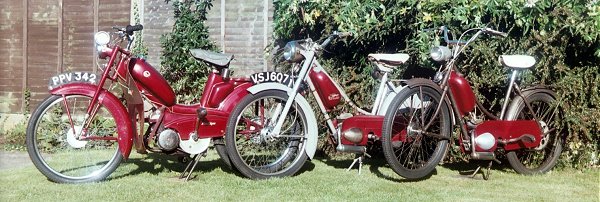
All three of our Phillips Pandas
Evening creeps upon the streets of Birmingham as the last of the rush hour traffic bumps and grinds its way home. Looking beyond the brim of our hat, the falling rain twinkles like a shower of gold as it shimmers past the yellow lens of the sodium arc streetlamps, then trickles away along the gutters in a phosphorescent stream. The comfort of our last cheroot smokes down to a stub, and we know we must escape this unrelenting weather.
Across the street, a bill poster outside a crumbling old theatre catches our eye.
"The Autocycle Roadshow - Last Performance Tonight"
"A presentation of ancient engineering. Marvel at the strange pivoting fork suspension systems…"
Intrigued, we pass a few coins over at the kiosk, and enter the musty gloom of the foyer. An usher holds aside a heavy curtain and beckons us down a dark passage. Walking through to the auditorium, we feel an involuntary shiver, and realise we've passed through another time veil - cold means the clock has slipped backwards again!
[Text and photos © 2009 M Daniels. Period documents from IceniCAM Information Service.]

The original receipt
for the Mk3 Phillips
Panda
The idea for what became the lead feature of IceniCAM 8 grew from the offer of the Phillips Panda Mk3 from Freda Mills, who bought this genuine one-owner bike new on 8th September 1962! Representing good value for money, these used to be quite a popular machine in the early '60s, but maybe the attrition rate has been high as they were the cheapest of the RM4 family, and certainly few are seen these days in comparable condition to this example. We obviously jumped at the opportunity to feature such a nice and original Mk3, while also recalling that David Evans ran a Panda Mk2 from his stable that we'd never got round to covering yet.
It's been a long time since the very first feature article on the Phillips Panda Mk1 and Raleigh RM2 in Clash of the Titans way back in February 2001, and things have moved on so much since those days that a re-visit was felt to be well justified, but that P40 was long since gone. Any real prospect of getting together all three Phillips Panda models in one super-feature was so tempting, it just had to be done, and all that would be required to complete the set ... would be restore the incomplete remains of a Panda Mk1 that had been hanging for years from the roof joists in the workshop! Certainly no mean prospect, since at this stage it comprised little more than a bare rolling chassis - but what IceniCAM does more than anything else is turn the impossible into reality!
The Mk1 rebuild proved quite a job to recover all the missing parts, and knowing how 'limited' the standard Rex motor could be, we got to wondering how one might go with uprated porting? As the earlier feature gave impressions of the original arrangement, it clinched the Mk1 motor would become a tweaked special, though the cycle was carefully reconstructed with all the correct fittings. The porting-modified cylinder by Rex Spares certainly pulled appreciably better at revs, and never suffered any of the irritating 4-stroking issues that afflict the standard motor.
David Evans's later Mk2 was always a good goer (for a stock Rex), and the 1.4bhp Moby-powered Mk3 added that third element to make a particularly intriguing comparison test, then shooting all three Panda models together must surely have created some iconic pictures for any Phillips fans.
The text file draft started back in January 2007 when the Panda Mk3 was test ridden on the 24th Mince Pie Run, but all credit for the title goes to Neil Morley, who upon seeing all three bikes standing in the workshop declared it was "Pandamonium". Brilliant! All other possible titles just went straight in the bin! As the Panda article evolved over the same period as In the Trade and The Autocycle Roadshow, all three grew inextricably together with probably the most iconic linked sequence of super-articles we've ever put together.
The Panda models all ran over a turbulent period for the British cycle industry, and the whole story became interwoven with the TI/Raleigh Group troubles of the time. The result was another vast article, primarily written for the 'Directors Cut' website version, since once again the feature had practically outgrown its printed medium.
Despite the considerable size, and huge amount of work in producing the Phillips article, costs were pretty low as all the bikes were local, so film, developing and CD barely rang up £10. Always with a reputation of having a keen eye for a bargain, Andy T of Tiernan Classics collects the sponsorship credit as a smart piece of promotion, so see his ads of latest bikes for sale.
| CAMmag Home Page | List of articles |